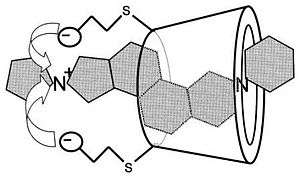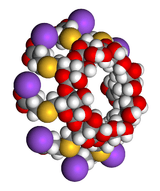Sugammadex
 | |
 | |
| Clinical data | |
|---|---|
| AHFS/Drugs.com | International Drug Names |
| License data | |
| Routes of administration | Intravenous |
| ATC code | V03AB35 (WHO) |
| Legal status | |
| Legal status | |
| Identifiers | |
| CAS Number |
343306-79-6 |
| PubChem (CID) | 6918584 |
| ChemSpider |
5293781 |
| UNII |
361LPM2T56 |
| KEGG |
D05940 |
| ChEBI |
CHEBI:90952 |
| Chemical and physical data | |
| Formula | C72H104Na8O48S8 |
| Molar mass | 2178 g/mol |
| 3D model (Jmol) | Interactive image |
| |
| |
| | |
Sugammadex (Org 25969, tradename Bridion) is an agent for reversal of neuromuscular blockade by the agent rocuronium in general anaesthesia. It is the first selective relaxant binding agent (SRBA).
Medical uses
Sugammadex is used to reverse neuromuscular blockade after administration of non-depolarizing neuromuscular-blocking agents such as vecuronium or rocuronium.
Pharmacology
Pharmacodynamics
Sugammadex is a modified γ-cyclodextrin, with a lipophilic core and a hydrophilic periphery. This gamma cyclodextrin has been modified from its natural state by placing eight carboxyl thio ether groups at the sixth carbon positions. These extensions extend the cavity size allowing greater encapsulation of the rocuronium molecule. These negatively charged extensions electrostatically bind to the quaternary nitrogen of the target as well as contribute to the aqueous nature of the cyclodextrin. Sugammadex's binding encapsulation of rocuronium is one of the strongest among cyclodextrins and their guest molecules. The rocuronium molecule (a modified steroid) bound within sugammadex's lipophilic core, is rendered unavailable to bind to the acetylcholine receptor at the neuromuscular junction.
 |
 |
Right: Space-filling model of a sugammadex sodium molecule in the same orientation.
Sugammadex, unlike neostigmine, does not inhibit acetylcholinesterase so cholinergic effects are not produced and co-administration of an antimuscarinic agent (glycopyrronium bromide or atropine) is not needed. Sugammadex might therefore be expected to have fewer adverse effects than the traditional reversal agents.
When muscle relaxant with rapid onset and short duration of action is required, there has been little choice apart from suxamethonium but this drug has important contraindications; for example, it can trigger malignant hyperthermia in susceptible individuals, it has a prolonged duration of action in patients with pseudocholinesterase deficiency and it causes an increase in plasma potassium concentration which is dangerous in some circumstances. Rocuronium has a comparably quick onset in high dose (0.6 mg kg−1 to 1 mg kg−1) and can be rapidly reversed with sugammadex (16 mg kg−1), so this drug combination offers an alternative to suxamethonium.
'Recurarisation', a phenomenon of recurrence of neuromuscular block, may occur where the reversal agents wear off before a neuromuscular blocking drug is completely cleared. This is very unusual with all but the longest acting neuromuscular blocking drugs (such as gallamine, pancuronium or tubocurarine). It has been demonstrated to occur only rarely with sugammadex, and only when insufficient doses were administered.[1] The underlying mechanism is thought to be related to redistribution of relaxant after reversal. It may occur for a limited range of sugammadex doses which are sufficient for complex formation with relaxant in the central compartment, but insufficient for additional relaxant returning to central from peripheral compartments.[2]
Sugammadex has been shown to have affinity for two other aminosteroid neuromuscular blocking agents, vecuronium and pancuronium. Although sugammadex has a lower affinity for vecuronium than for rocuronium, reversal of vecuronium is still effective because fewer vecuronium molecules are present in vivo for equivalent blockade: vecuronium is approximately seven times more potent than rocuronium. Sugammadex encapsulates with a 1:1 ratio and therefore will adequately reverse vecuronium as there are fewer molecules to bind compared to rocuronium.[3] Shallow pancuronium blockade has been successfully reversed by sugammadex in phase III clinical trials.[4]
Efficacy
A study was carried out in Europe looking at its suitability in rapid sequence induction. It found that sugammadex provides a rapid and dose-dependent reversal of neuromuscular blockade induced by high-dose rocuronium.[5]
A Cochrane review on sugammadex concluded that "sugammadex was shown to be more effective than placebo (no medication) or neostigmine in reversing muscle relaxation caused by neuromuscular blockade during surgery and is relatively safe. Serious complications occurred in less than 1% of the patients who received sugammadex. The results of this review article (especially the safety results) need to be confirmed by future trials on larger patient populations".[6]
Tolerability
Sugammadex was generally well tolerated in clinical trials in surgical patients or healthy volunteers. In pooled analyses, the tolerability profile of sugammadex was generally similar to that of placebo or neostigmine plus glycopyrrolate.[7]
History
Sugammadex was discovered by the pharmaceutical company Organon at the Newhouse Research Site in Scotland.[8] Organon was acquired by Schering-Plough in 2007; Schering-Plough merged with Merck in 2009. Sugammadex is now owned and sold by Merck.
The US Food and Drug Administration (FDA) initially rejected Schering-Plough's New Drug Application for sugammadex in 2008,[9] but finally approved the medication for use in the United States on December 15, 2015.[10] Sugammadex was approved for use in the European Union on July 29, 2008.[11]
References
- ↑ Miller R (2007). "Sugammadex: an opportunity to change the practice of anesthesiology?". Anesth Analg. 104 (3): 477–8. doi:10.1213/01.ane.0000255645.64583.e8. PMID 17312188.
- ↑ Eleveld DJ; Kuizenga, K; Proost, JH; Wierda, JM (2008). "A Temporary Decrease in Twitch Response During Reversal of Rocuronium-Induced Muscle Relaxation with a Small Dose of Sugammadex". Anesth Analg. 104 (3): 582–4. doi:10.1213/01.ane.0000250617.79166.7f. PMID 17312212.
- ↑ Welliver M (2006). "New drug sugammadex; A selective relaxant binding agent". AANA J 74(5): 357–363. PMID 17048555
- ↑ Decoopman M (2007). "Reversal of pancuronium-induced block by the selective relaxant binding agent sugammadex". Eur J Anaesthesiol. 24(Suppl 39):110-111.
- ↑ Pühringer FK, Rex C, Sielenkämper AW, et al. (August 2008). "Reversal of profound, high-dose rocuronium-induced neuromuscular blockade by sugammadex at two different time points: an international, multicenter, randomized, dose-finding, safety assessor-blinded, phase II trial". Anesthesiology. 109 (2): 188–97. doi:10.1097/ALN.0b013e31817f5bc7. PMID 18648227.
- ↑ Abrishami A, Ho J, Wong J, Yin L, Chung F. (October 2009). Abrishami, Amir, ed. "Sugammadex, a selective reversal medication for preventing postoperative residual neuromuscular blockade". Cochrane Database of Systematic Reviews (4): CD007362. doi:10.1002/14651858.CD007362.pub2. PMID 19821409.
- ↑ Yang LPH, Keam SJ..Drugs 2009;69(7):919-942. doi:10.2165/00003495-200969070-00008.
- ↑ Naguib M (2007). "Sugammadex: another milestone in clinical neuromuscular pharmacology.". Anesth Analg 104(3): 575–81. PMID 17312211
- ↑ "U.S. FDA Issues Action Letter for Sugammadex" (Press release). Schering-Plough. 2008-08-01. Retrieved 2008-08-02.
- ↑ "FDA approves Bridion to reverse effects of neuromuscular blocking drugs used during surgery" (Press release). Food and Drug Administration. 2015-12-15. Retrieved 2015-12-15.
- ↑ "BRIDION(R) (sugammadex) Injection - First and Only Selective Relaxant Binding Agent - Approved in European Union" (Press release). Schering-Plough. 2008-07-29. Retrieved 2008-08-02.